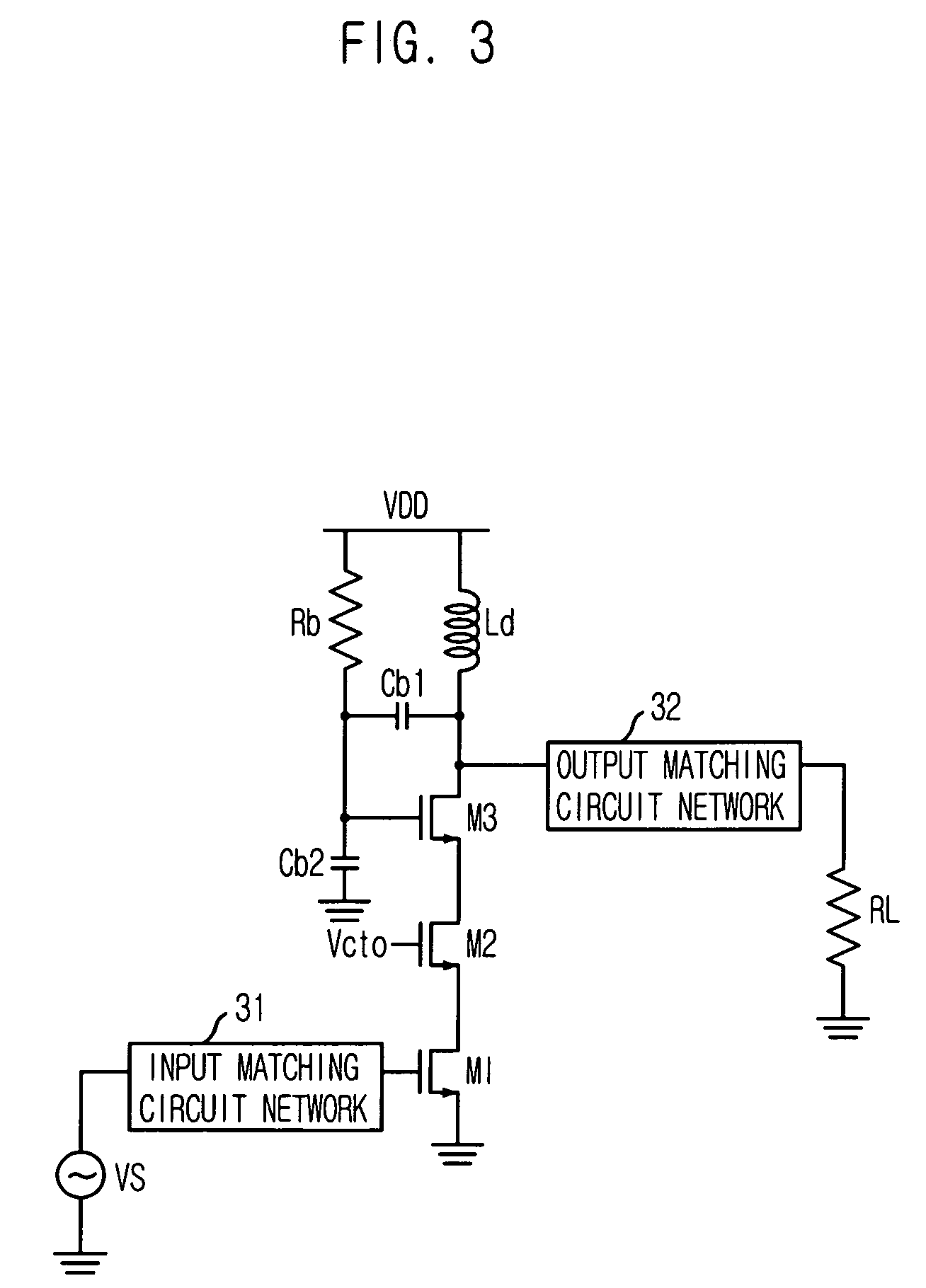Triple cascode power amplifier of inner parallel configuration with dynamic gate bias technique
a power amplifier and cascode technology, applied in the direction of gated amplifiers, amplifiers with semiconductor devices only, amplifiers with semiconductor devices, etc., can solve the problems of low efficiency, difficult to design high-power amplifiers, and low breakdown voltage between gates and drains
- Summary
- Abstract
- Description
- Claims
- Application Information
AI Technical Summary
Benefits of technology
Problems solved by technology
Method used
Image
Examples
first embodiment
[0026]FIG. 3 is a circuit diagram showing a power amplifier in accordance with a first embodiment of the present invention.
[0027]As shown in FIG. 3, the power amplifier suggested in the first embodiment of the present invention has a triple cascode configuration including a dynamic gate bias by a voltage divider with capacitors Cb1 and Cb2. The triple cascode configuration is formed based on a serial connection of a common source transistor M1, a common gate transistor M2, and a transistor M3 with a dynamic gate bias.
[0028]The common source transistor M1, which is the first stage of the triple cascode configuration, is connected to ground at a source, connected to the source of the common gate transistor M2 at a drain, and connected to the input matching circuit network 31 at a gate. Considering the mentioned configuration, an input signal Vs impedance-matched through the input matching circuit network 31 is coupled to the gate of a common source transistor M1, amplified and outputt...
second embodiment
[0034]FIG. 4 is a circuit diagram describing the power amplifier suggested in the second embodiment of the present invention. It shows an example realizing a triple cascode power amplifier of the first embodiment in inner-parallel configuration.
[0035]As shown in FIG. 4, the power amplifier suggested in the second embodiment of the present invention has a configuration that three common gate transistors M2a to M2c and three common source transistors M1a to M1c are connected in parallel cascode configuration in addition to the configuration of the first embodiment. Herein, the number of the cascode branches, which are connected in parallel, is three, but the number is only for the sake of convenience in explanation and it can be varied properly.
[0036]The power amplifier of the second embodiment has a configuration for increasing efficiency in a low power mode while taking the advantages of the power amplifier of the first embodiment. In the configuration, cascode branches that three t...
third embodiment
[0054]FIG. 7 is a circuit diagram showing a power amplifier in accordance with a third embodiment of the present invention. Herein, the power amplifier having dynamic bias current and dynamic bias voltage in accordance with a third embodiment of the present invention is an example originated from the power amplifier in accordance with the second embodiment shown in FIG. 4.
[0055]As shown in FIG. 7, the power amplifier of the third embodiment further includes a detecting block 76 for detecting the amplitude of an input signal Vs in the power amplifier shown in FIG. 4 and a voltage providing block 73 for controlling an amplitude of DC supply voltage according to a control signal of the detecting block 76.
[0056]In the respect of a bias, a DC gate bias of the dynamic bias transistor M3 in the third stage is determined to be equal to a dynamic supply voltage and a dynamic gate bias according to the amplitude of an output signal is determined by a voltage divider of capacitors Cb1 and Cb2 ...
PUM
 Login to View More
Login to View More Abstract
Description
Claims
Application Information
 Login to View More
Login to View More - R&D
- Intellectual Property
- Life Sciences
- Materials
- Tech Scout
- Unparalleled Data Quality
- Higher Quality Content
- 60% Fewer Hallucinations
Browse by: Latest US Patents, China's latest patents, Technical Efficacy Thesaurus, Application Domain, Technology Topic, Popular Technical Reports.
© 2025 PatSnap. All rights reserved.Legal|Privacy policy|Modern Slavery Act Transparency Statement|Sitemap|About US| Contact US: help@patsnap.com



